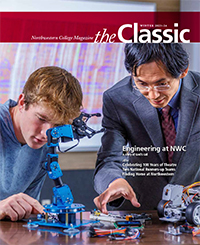Computer programming team to compete in world finals
Thursday, December 11, 2008
A team of three
“Since September, 7,000 teams from 88 countries have participated in regional competitions,” says Michael Wallinga, instructor in computer science at Northwestern. “To have the international organization recognize a school of our size as one of the top 100 teams in the world, out of more than 1,800 colleges and universities, is a great honor and a validation of the team’s high level of performance.”
Members of the Northwestern team are John Calsbeek, a junior computer science major from Orange City; Ben Kester, a senior actuarial science and computer science major from Urbandale, Iowa; and Curt Van Wyk, a senior mathematics teaching and computer science major from George, Iowa. Each of them has participated on previous Northwestern squads that finished in the top 10 regionally.
“John, Ben and Curt are all phenomenal students. They put in a lot of time preparing for the contest and are smart in their approach, working on the easiest problems first,” says Wallinga. “The guys have already looked at sample problems from past world finals, and they recognize the difficulty increases at this level. They plan to have regular practice sessions in the second semester and pick up right where they left off.”
At the world finals, the Northwestern team will compete with students from MIT, Moscow State University, Oxford, Stanford, the University of Melbourne and the University of Warsaw, to name a few. Iowa State University is the only other school from Iowa to be selected.
The competition, in its 33rd year and sponsored by IBM, challenges students to solve real-world problems using open technology and advanced computing methods under a five-hour deadline. Huddled around a single computer, teams of three students collaborate to deduce the requirements, design test beds and build software systems under the scrutiny of expert judges. The winning team is the one that solves the most problems in the fewest attempts within the least amount of time.

